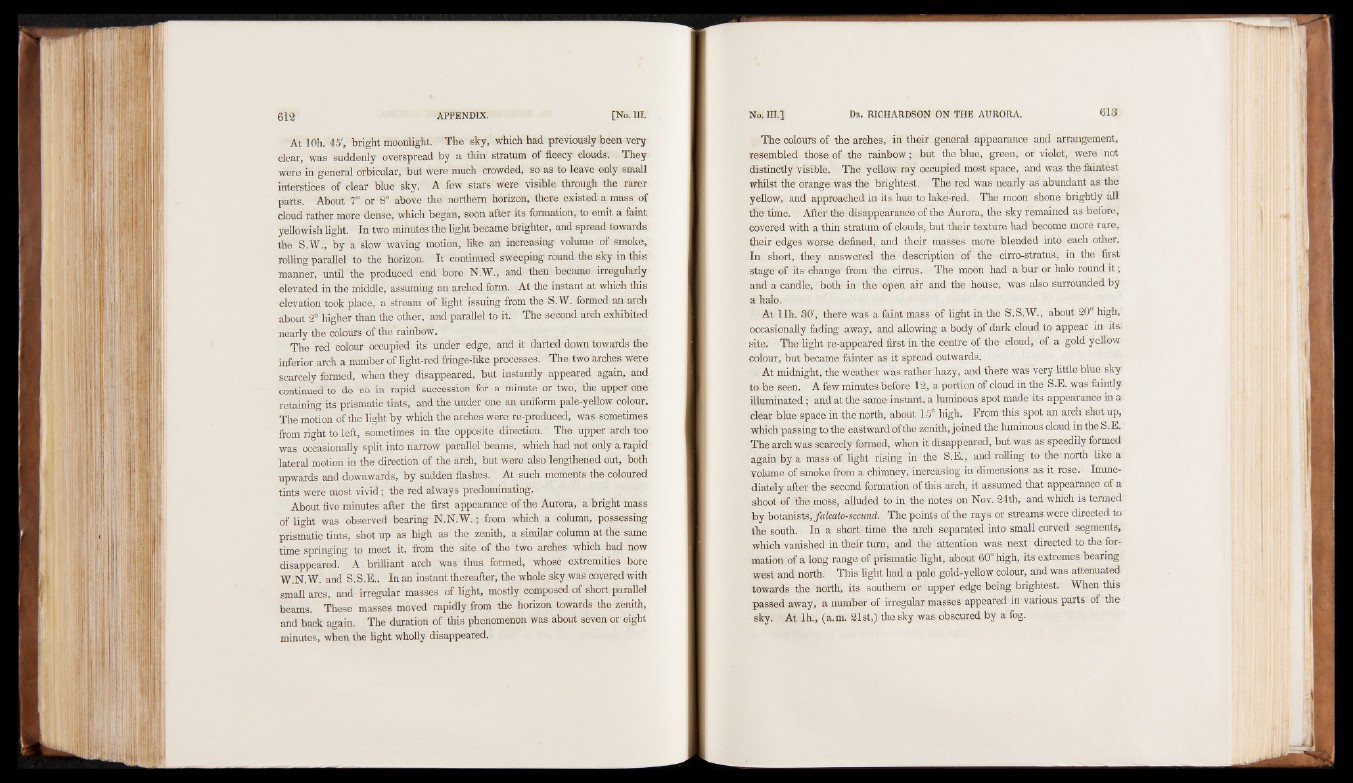
At lOh. 45', bright moonlight. The sky, which had previously been very
clear, was suddenly overspread by a thin stratum of fleecy clouds. They
were in general orbicular, but were much crowded, so as to leave only small
interstices of clear blue sky. A few stars were visible through the rarer
parts. About 7° or 8° above the northern horizon, there existed a mass of
cloud rather more dense, which began, soon after its formation, to emit a faint
yellowish light. In two minutes the light became brighter, and spread towards
the S.W., by a slow waving motion, like an increasing volume of smoke,
rolling parallel to the horizon. It continued sweeping round the sky in this
manner, until the produced end bore N.W., and then became irregularly
elevated in the middle, assuming an arched form. At the instant at which this
elevation took place, a stream of light issuing from the S.W. formed an arch
about 2° higher than the other, and parallel to it. The second arch exhibited
nearly the colours of the rainbow,
The red colour occupied its under edge, and it darted down towards the
inferior arch a number of light-red fringe-like processes. The two arches were
scarcely formed, when they disappeared, but instantly appeared again, and
continued to do so in rapid succession for a minute or two, the upper one
retaining its prismatic tints, and the under one an uniform pale-yellow colour.
The motion of the light by which the arches were re-produced, was sometimes
from right to left, sometimes in the opposite direction. The upper arch too
was occasionally split into narrow parallel beams, which had not only a rapid
lateral motion in the direction of the arch, but were also lengthened out, both
upwards and downwards, by sudden flashes. At such moments the coloured
tints were most vivid: the red always predominating.
About five minutes after the first appearance of the Aurora, a bright mass
of light was observed bearing N.N.W.; from which a column, possessing
prismatic tints, shot up as high as the zenith, a similar column at the same
time springing to meet it, from the site of the two arches which had now
disappeared. A brilliant arch was thus formed, whose extremities bore
W.N.W. and S.S.E.. In an instant thereafter, the whole sky was covered with
small arcs, and irregular masses of light, mostly composed of short parallel
beams. These masses moved rapidly from the horizon towards the zenith,
and back again. The duration of this phenomenon was about seven or eight
minutes, when the light wholly disappeared.
The colours of the arches, in their general appearance and arrangement,
resembled those of the rainbow; but the blue, green, or violet, were not
distinctly visible. The yellow ray occupied most space, and was the faintest
whilst the orange Was' the brightest. The red was nearly as abundant as the
yellow, and approached in its hue to lake-red. The moon shone brightly all
the time. After the disappearance of the Aurora, the sky remained as before,
covered with a thin stratum of clouds, but their texture had become more rare,
their edges worse defined, and their masses more blended into each other.
In short, they answered the description of the cirro-stratus, in the first
stage of its-change' from the cirrus. The moon had a bur or halo round it;
and a candle, both in the open air and the house, was also surrounded by
a halo.
At llh. 30', there was a faint mass of light inlthe S.S.W., about 20° high,
occasionally fading away, and allowing a body of dark cloud to appear in its;
site; The light re-appeared first in the centre of the cloud, of a gold yellow
colour, but became fainter as it spread outwards.
At midnight, the weather was rather hazy, and there was very little blue sky
to be seen. A few minutes before 12, a portion of cloud in the S.E. was faintly
illuminated; and at the same instant, a luminous spot made its appearance in a
■ clear blue space in the north, about 15° high. From this spot an arch shot up,
which passing to the eastward of the zenith, joined the luminous cloud in theS.E.
The arch was scarcely formed, when it disappeared, but was as speedily formed
again by a mass of light rising in the S.E., and rolling to the north like a
volume of smoke from a chimney, increasing in dimensions as it rose. Immediately
after the second formation of this arch, it assumed that appearance of a
shoot of the moss, alluded to in the notes on Nov. 24th, and which is termed
by botanists, falcato-secund. The points of the rays or streams were directed to
the south. In a short time the arch separated into small curved segments,
which vanished in their turn, and the attention was next directed to the formation
of a long range of prismatic light, about 609 high, its extremes bearing
west and north. This light had a pale gold-yellow colour, and was attenuated
towards the north, its southern or upper edge being brightest. When this
passed away, a number of irregular masses appeared in various parts of the
sky. At lh., (a.m. 21st,) the sky was obscured by a fog.